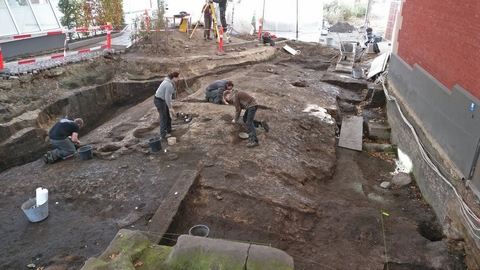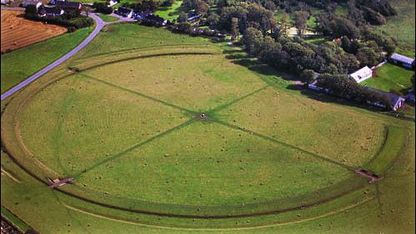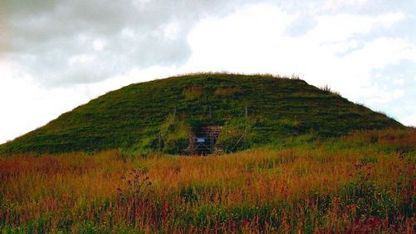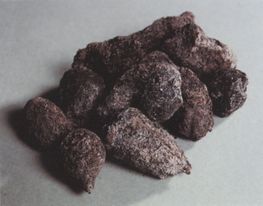
Archaeological sources for the Viking Age
There are several elements that determine whether an artefact belongs to the archaeological sources for the Viking Age. They are the physical conditions that surround the artefact and the archaeological method by which it is excavated, registered and documented.
The physical conditions, agriculture and preservation circumstances
The overall picture of an artefact is often determined by the landscape. Developments in agriculture such as ploughing, cultivation, draining of wetlands and establishment of new wooded areas have great importance for the preservation of artefacts and antiquities.
Today, more artefacts are found in older, untouched wooded areas than in the open landscape, where they are destroyed by agriculture.
In the 1800s, during the reform of agriculture, a large number of passage graves, dolmens and burial mounds disappeared because it was decided to drain wetlands to turn them into areas of cultivation. But the remains of settlements and graves also disappear through development of and changes to the landscape. Settlement finds and high-lying graves are often endangered by ordinary agricultural ploughing and deep-lying graves and burial mounds are taken out of their proper context during deep ploughing in connection with forestation.
Glossary
The term "archaeological sources" refers to two kinds of thing: ancient monuments and artefacts.
An ancient monument is something fixed - a standing building, a burial mound, or a stone structure.
An artefact is usually found in an ancient monument. It is a moveable object recovered by archaeological excavation and often kept in a museum.
Oxygen and iron content
The preservation conditions of the soil (acid or alkaline environment) also determine the overall picture of an artefact. The admission of oxygen and the iron content in particular determine what is preserved. Organic materials such as wood, cloth, skin and hair start to rot more quickly if they are in contact with oxygen.
One example is the Egtved Girl from the Bronze Age. The girl was laid to rest in a burial mound made of peat containing traces of iron. Over the many hundreds of years the rain has washed the iron from the peat and it has formed a shell in the mound, called the hardpan layer. Year by year, this layer moves further in towards the centre of the burial mound and prevents oxygen entering the mound. That was why the oak coffin, the girl’s skin, hair, nails and clothing were preserved. Iron objects and the bones had disappeared.
Iron artefacts such as weapons, coins, tools and surgical instruments and bones that contain keratin and calcium are preserved best if there is access to oxygen. There can therefore be large differences in the overall picture of an artefact from for instance bogs with corpses or victims of spoils of war.
Archaeological method
The working methods of archaeologists are also important for the overall picture of artefacts and subsequent documentation. There is a crucial difference between an archaeologist carrying out a proper excavation and just going over an area with a detector looking for surface finds. In both cases the working method and interpretation of the finds are subjective processes where there is selection between important and less importance objects, details and information.
Monuments
Because of their size, the surviving ancient monuments from the Viking Age are very striking elements in the Danish landscape and provide visible evidence of cultural life, religion and political power.
Many of the Viking Age’s prestige monuments were created to mark royal power structures. For instance, Harald Bluetooth had the largest royal memorial of the Viking Age set up at Jelling. When Harald’s father Gorm the Elder, was driven out of Hedeby he settled in Jelling, and the creation of the monument is undoubtedly a demonstration of the power of the family in a new area and a marking of both kings’ achievements.
Other well-known ancient monuments include the Danevirke defensive structure in Southern Jutland/Schleswig, the circular strongholds, and the bridge across Ravninge meadows near Vejle. Common to these structures is that they tell us about the economic power of the Viking kings and the transition to centralised power in Denmark. The burial mounds, defensive works, strongholds and the numerous roads and bridges constructed through difficult landscapes demanded a colossal amount of manual labour, which is evidence of a strong king who had power and money to levy a large workforce.
Artefacts
An artefact can be characterised as being a moveable object and includes not just jewellery, weapons, tools and everyday things such as clay pots, pans, combs and clothes. Artefacts can also be rubbish in the form of bones from slaughtered animals or iron slag from production of weapons or tools at a smithy. Some non-fashioned objects found a settlement can also be regarded as artefacts if it can be shown that the object has been used by people.
There is no limit to the size of an artefact as long as the find can be transported from where it was found.
The ships of the Viking Age are also artefacts and finds of them have been of enormous significance for our understanding of the maritime culture in Viking times. The ships provide evidence of culture both on land and at sea. They give an insight into the Viking Age’s boat-building traditions, the organisation of shipbuilding, tools, materials and types of ship, and also into the organisation of naval fleets and merchant voyages.
On the basis of the dimensions of a ship, it is possible to interpret its sailing qualities, cargo capacity, rigging and crew, as well as assess where the ship could have sailed. The ship finds confirm that the Vikings’ expeditions of pillage and conquest and their voyages across the North Atlantic were indeed possible.
By: Louise Kæmpe Henriksen
Did you know..
..that under the right conditions even the excrement from humans and animals can be preserved? It is a valuable archaeological source, telling us about daily life and food.


